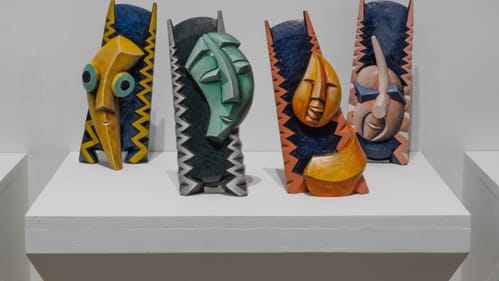Stay in the Loop
BSR publishes on a weekly schedule, with an email newsletter every Wednesday and Thursday morning. There’s no paywall, and subscribing is always free.
Family trees
The Museum for Art in Wood presents La Famiglia

The exhibition is called La Famiglia. But it could easily, and cheekily, be titled Family Trees. In this collection of turned-wood figures and faces—both whimsical and profound—artist Mark Sfirri pokes at questions of likeness and difference, ancestry and environment: are families forged from a common root, a set of shared experiences, or a series of accidents and choices?
The work says yes: all of the above.
Arriving at Ellis Island
At first glance, the two dozen or so carved figures in The Ellis Islanders, at the show’s start, seem to share a common trait of foreignness, a certain not-from-here look around the eyes. Immigrants. A monolith.
But on closer examination, nuances emerge. One figure wears a fez; another, a beret. Some noses are bulb-shaped while others are tidy isosceles triangles. Brows furrow or relax. The tallest figure is the size of a pepper mill. The smallest stands a squat few inches high.
Look longer, and the assemblage becomes dynamic: the figures vary in expression, posture, and configuration, each slightly off-kilter because Sfirri turns the wood on dual axes. There’s something precarious and restive about this crowd; you can imagine the soundtrack, a cacophony of global tongues.
The immigrant experience is central to La Famiglia and to Sfirri, the grandchild of four first-generation Americans who came through Ellis Island at the turn of the 20th century and settled in Chester.
A paradox of the human condition
Working in a variety of native woods—pine, walnut, ash, red oak, Douglas fir, poplar, holly, and Western yellow cedar—Sfirri and exhibition curator Jennifer-Navva Milliken remind us that we are shaped both by the rootstock from which we come and by the marks life leaves on us.
Forest for the Trees, a large installation that stands on the museum’s floor, is more abstract than The Ellis Islanders. These “figures” resemble trees, or totem poles, more than humans—faceless, yet each with its own energy and temperament, united because they all come from wood, yet wildly different in density, color, luster, and patterns of striation.
In an accompanying placard, Sfirri explains that he didn’t intend to create a forest: “These pieces were not planned to be a part of a group until I had made enough of them to consider them a group.” Together, they capture a paradox of the human condition: that each of us is at once utterly unique and a member of multiple, intersecting tribes.
Heroes, villains, and familiar strangers
Heroes and Villains pokes at stereotypes and our propensity to label people as “good” or “bad.” All the figures in this work are turned from French pearwood, and they are larger than the Ellis Islanders—scaled up, Sfirri explains on the placard, “to give them more of the presence of statues of the rich and famous.”
Without further identification, I couldn’t help starting to pigeonhole the figures: that one looks clownish, and others seem stodgy, or dour, or doubtful. Which ones are exemplary people? Which ones are swindlers, liars, or grumps? They come from the same stock, after all. As Sfirri writes, “It’s a little tricky to distinguish the good from the bad.”
The piece called Family Tree beckoned me from across the room with its bold colors and exuberantly expressive faces, a set of three-dimensional portraits made from Western yellow cedar and paint that seem to pop from their frames, designed to emphasize contrasts, angles, and shapes.

Set on three white shelves, these “portraits” in wood stare out, eyes wide or with lids half-drawn, faces colored russet or ice blue or teal, inviting us to locate ourselves amidst the crowd. This “family” feels like one formed by volition rather than accidents of birth, a motley group of strangers—the goofy, the demonic, the profound—brought together in a particular place and time.
Never working alone
We know now, thanks in part to the work of forest ecologist Suzanne Simard, that trees function communally—sharing information about disease and pests, exchanging phosphorus and nitrogen, nursing saplings through a lacy fungal network underground.
Sfirri’s work plays with ideas of generativity and collaboration. In the placard accompanying Cubist Tray Family, he notes that each piece is a “nest for holding objects.” Nests incubate and harbor; they are the cradle for the next generation. These wood-carved nest trays are each anchored at one end by a cube (a family trait?) while expressing their distinctiveness in size, color, texture, and capacity.
Like his subjects—trees and humans who co-exist in family groups—Sfirri doesn’t always work alone. He launched a collaborative project for La Famiglia, gathering the work of 45 artists who each contributed a two-dimensional artwork, literal or conceptual, depicting an “immigrant.”
The images, arranged in nine-panel grids that resemble window frames, juxtapose artistic styles, media, and approaches. There are pencil sketches, pastels, watercolors, and prints. One, by Sandra Scicchitani, depicts “the grandmother I never knew” who dropped dead of a stroke at age 61.
Another, by Paul Sasso, shows a hand holding a stone-working chisel. The artist wrote that for his ancestors, who emigrated from Teano, Italy, to Canada and then to the United States, “tools and skills were essential to survival.”
It’s worth taking the time to read each artist’s explanation of their image; together, like every piece in La Famiglia, they emphasize that among humans, as among trees, every individual is different, yet nothing is the only one of its kind.
What, When, Where
La Famiglia. Through February 16, 2025, at the Museum for Art in Wood, 141 N 3rd Street, Philadelphia. (215) 923-8000 or museumforartinwood.org.
Accessibility
The Museum for Art in Wood is a wheelchair-accessible venue.
Sign up for our newsletter
All of the week's new articles, all in one place. Sign up for the free weekly BSR newsletters, and don't miss a conversation.

 Anndee Hochman
Anndee Hochman